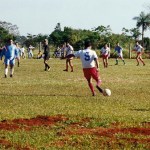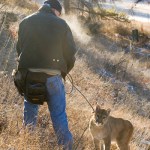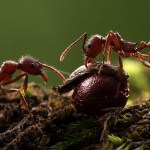Nature
tags: evolution, biogeography, phylogeography, animals, Here Be Dragons, How the Study of Animal and Plant Distributions Revolutionized Our Views of Life and Earth, Dennis McCarthy, book review
I'm happy: another book review of mine was just published, this time, by Science magazine. This book, Here Be Dragons: How the Study of Animal and Plant Distributions Revolutionized Our Views of Life and Earth (Oxford University Press: Oxford; 2009), is by Dennis McCarthy, a researcher at the Buffalo Museum of Science in Buffalo, New York. In short, I liked the book and I thought it was generally well-…
Something took a bite out of this leaf:
What was it?
Three points for the taxonomic order of the culprit, five for family, and two for explaining the natural history. Points are awarded only for the first correct guess in each category. And maybe some extra ones if you get creative with the natural history.
The cumulative points winner for the month of June 2010 will get their choice of 1) any 8x10 print from my photo galleries; or 2) a guest post on the safe-for-work topic of their choice.
Apropos of Paraguay's victory in this morning's world cup match against Slovakia, here's a photo I took almost 15 years ago:
This is a local match in the Paraguayan community where I lived as a Peace Corps volunteer. Our team, from Colonia 11 de Setiembre, beat Ype Jhu 2-1.
But that's not why I'm sharing the picture. Do you see all that dirt mounded up in the foreground? That's a mature nest of Atta sexdens, a leafcutter ant, right on the playing field.
I guess there are two points here. First, ants are an ubiquitous presence in Paraguay, getting into just about everything. It's a…
A dagger fly (Diptera: Empididae), eating a fly it caught.Shawnee National Forest, Illinois
Among the insects, one lineage in particular excels in the air: Diptera, the flies. These animals have evolved a gyroscopic control system that's faster and more efficient than the standard insect sensory system, and as a consequence the flies are the most agile fliers on our planet. Their numbers include some spectacularly maneuverable aerial predators such as the fly pictured here, hanging from a leaf to consume its prey.
Photographing these subjects posed two problems. First, flies are highly…
I haven't posted any ants for awhile. So here is a pair of little carpenter ants from the back yard:
Camponotus nearcticus
Camponotus caryae
Most people in North America think of carpenter ants as the big hairy black things that damage houses by chewing through older and dry-rotted wood. That's certainly true of Camponotus pennsylvanicus, the eastern black carpenter ant.
But the genus contains many smaller and less conspicuous species that nest in pre-formed cavities and plant stems, foraging for scraps and honeydew and generally bothering no one. The two pictured here are both abundant…
And that's Nature as in Nature Publishing Group rather than the narrative strategy.
I missed the story when it broke earlier this week in The Chronicle -- I was attending the absolutely fantastic Canadian Engineering Education Association conference in Kingston from Monday to Wednesday. And when I got back, Thursday and Friday weren't the types of days that were conducive to blogging. I'm still feeling a bit behind on the whole issue so doing this post is helping to feel a bit more up-to-speed.
The story, from the Chronicle article that more-or-less started it all, U. of California Tries…
Glischrochilus sanguinolentus
Bell Smith Springs, Illinois
Just for you guys, here are some portraits of a colorful sap beetle in the family Nitidulidae I encountered in southern Illinois last weekend. It's a charming little insect, especially the cute, clubby antennae.
The challenge with shooting shiny insects such as Glischrochilus is lighting the insect without glare. The back of this animal is like a mirror, and if I were to just use the available sunlight or a bare camera flash all I'd get is a blown-out spot reflection of the light source with the rest of the animal appearing dark and…
Audubon's Ted Williams explains that staged images have taken over the animal photography business and argues that these ubiquitous phonies give the public an inaccurate view of nature:
Audubon has sent me to lots of wild places over the past 31 years, but I'd seen only one wolf and three cougars (a litter) until December 8, 2009. On that day, before noon in the Glacier National Park ecosystem of northwestern Montana, I encountered not just one wolf but two and not just one cougar but two! What were the chances of that?
Well, they were 100 percent, because I'd rented the animals for a photo…
Oberea flavipes, phlox stem borer beetlesIllinois
Here's a boring beetle.
That is, the larvae bore. They make their living carving tunnels through stems and consuming plant tissue. This pair was hanging out in the phlox in our back yard, apparently plotting the demise of our summer flower garden.
photo details:
Canon EOS 7D camera
Canon MP-E 65mm 1-5x macro lens
ISO 100, f/13, 1/250sec
diffused twin flash
Thanks to Rob Mitchell for the ID.
Aphaenogaster woodland ants disperse a bloodroot seed. This image materialized in my head a couple months before I actually set it up.
My photographs fall into two categories: incidental shots I happen upon by chance, and premeditated images mapped out in advance. There's not much to say about the first type. I wander about in the woods as another camera-toting tourist, and sometimes I get lucky with an interesting subject. A naturalist's eye and a basic ability to operate photographic equipment suffice to produce usable photos.
As my photographic career progresses, though, more of my…
tags: Kurjenpolvi, flowers, travel, gardening, Helsingin yliopisto, University of Helsinki, Helsinki, Finland, image of the day, photography
Kurjenpolvi.
A red-and-white geranium photographed at Helsingin yliopisto (University of Helsinki) in Helsinki, Finland.
Image: GrrlScientist, 18 May 2010 [larger view]
Canon SX100 IS.
tags: Puna-keltaisia kukkia, flowers, travel, gardening, Helsingin yliopisto, University of Helsinki, Helsinki, Finland, image of the day, photography
Puna-keltaisia kukkia.
A red-and-yellow Evening Primrose, Oenothera macrocarpa, photographed at Helsingin yliopisto (University of Helsinki) in Helsinki, Finland.
Image: GrrlScientist, 18 May 2010 [larger view]
Canon SX100 IS.
Selling a work fiction is difficult; publishing in Nature is a long-shot; yet somehow writer and genomeboy Misha Angrist managed to publish fiction in Nature.
The only way I was ever going to get a first-author publication in Nature [Angrist explains] was if I just made it all up. So thatâs what I did. Hat tip to David Dobbs for providing the scientific inspiration.
The short story/fantasy Angrist publishes actually pulls little, it seems to me, from my story about the orchid/plasticity/differential susceptibility hypothesis, though it does work ground seeded by both genetics and…
This looks like it could be painful. What is it?
Five points to the first person to name the organism, and five for the structure.
The cumulative points winner for the month of May will win either 1) any 8x10 print from my insect photo gallery, or 2) a guest blog post on the (safe-for-work) topic of their choosing.
[SEM image by the lovely and talented Elle Camino]
tags: flowers, Purppura Päivänkakkaraa, travel, Kaisaniemi Botanic Garden, University of Helsinki, Helsinki, Finland, image of the day, photography
Vaaleanpunainen Päivänkakkara.
Photographed in the Kaisaniemi Botanic Garden, University of Helsinki, Helsinki, Finland.
Image: GrrlScientist, 18 May 2010 [larger view]
Canon SX100 IS.
Here's a silly thing that you might enjoy. When naming this image, I used Google translate to check my Finnish because, well, we all know why. Anyway, I found something weird (you can check this for yourself if you are so ambitious):
English
Finnish…
tags: flowers, Vaaleanpunainen Päivänkakkara, travel, Suomenlinna, Helsinki, Finland, image of the day, photography
Vaaleanpunainen Päivänkakkara.
Photographed in the Kaisaniemi Botanic Garden, University of Helsinki, Helsinki, Finland.
Image: GrrlScientist, 18 May 2010 [larger view]
Canon SX100 IS.
tags: nature, Keväällä Suomenlinnassa, travel, Suomenlinna, Helsinki, Finland, image of the day, photography
Keväällä Suomenlinnassa.
Photographed on the island of Suomenlinna, Helsinki, Finland.
Image: GrrlScientist, 20 May 2010 [larger view]
Canon SX100 IS.
This is one of the last photographs I snapped in Helsinki -- I chose to spend my last day in Finland on the historical island fortress of Suomenlinna (which is one of my favorite places to go and to photograph). One of my goals is to return to Helsinki and to stay in a hotel on the island of Suomenlinna (preferably in winter)…
tags: Pay Attention to Penguins, birds, penguins, environment, global warming, ethics, climate change, Dee Boersma, TEDTalks, TED Talks, streaming video
Think of penguins as ocean sentinels, says Dee Boersma -- they're on the frontlines of sea change. Sharing stories of penguin life and culture, she suggests that we start listening to what penguins are telling us.
TEDTalks is a daily video podcast of the best talks and performances from the TED Conference, where the world's leading thinkers and doers give the talk of their lives in 18 minutes. Featured speakers have included Al Gore on…
Biologist Henry Hespenheide sends along this shot of several ant-mimicking beetles and their Cephalotes model:
What I take from this image is just how important the appearance of a narrow waist must be to successfully pulling off the illusion. These mimics differ considerably in body proportions, but they have all managed to paint a fake waist on their elytra.










